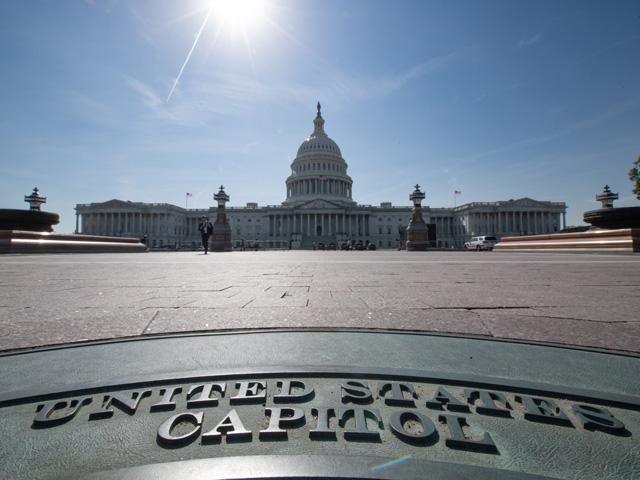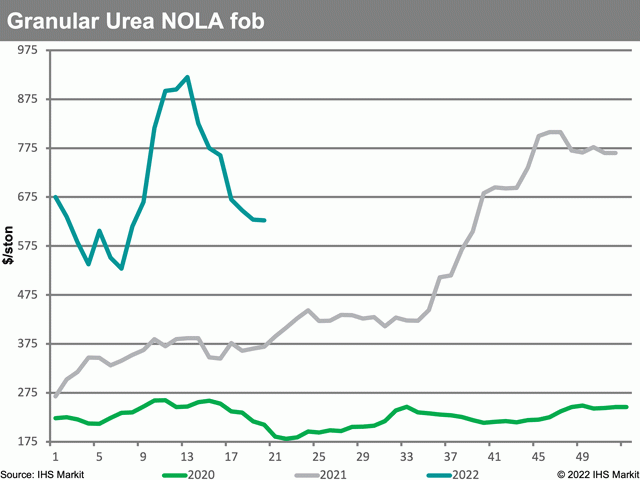DTN Fertilizer Outlook
Wholesale Fertilizer Prices Fall on Sluggish Spring Demand
The following is a recap of fertilizer price trends and market developments for May.
AMMONIA
Domestic:
For the first time this spring, the month of May saw some ammonia prices falling in the U.S., owed to a sharply lower Tampa ammonia contract settlement and largely disappointing spot demand due to poor weather conditions for the planting season so far.
U.S. Gulf Coast prices fell back below $1,000 per short ton (t) free-on-board (FOB -- sales price without any transportation costs factored in), but offers in other parts of the country were slow to respond to the weakening market.
Producers still saw some demand left in the planting season last month and had little pressure to lower spot prices ahead of expected fill sales later this year. Corn Belt ammonia volumes were still offered in the $1,400 and $1,500s as a result, unchanged from April prices.
Factory prices did see some reductions late in the month, with low offers in eastern Oklahoma coming in at $1,200/t FOB or $25 lower month-over-month.
Last year, initial summer-fill offers from CF and Koch Industries took place over a two-hour window at a range of $560-$585/t FOB Corn Belt, $540 in Kansas, $550-$565 Nebraska, and $560 Eastern Oklahoma plants. Several U.S. ammonia plants were also out of commission for turnaround when the announcements came in late June.
Sidedress demand is expected to be more important for ammonia sellers this year, given the preplant application window was cut short by poor weather in March and April. With some in the market predicting summer-fill offers to come out around $900-$1,000/t, our short-term price outlook for ammonia is lower, but could also see support for higher prices due to increased natural gas prices.
International:
In May, Yara and Mosaic agreed a price at Tampa of $1,000 per metric ton (mt) cost-and-freight (CFR -- sale price including transportation costs) for June, down $425 on the $1,425 CFR Tampa number agreed by Yara and Mosaic for May. This is the lowest settlement at Tampa since December and came as a surprise to the market, having widely expected prior to the announcement that Yara and Mosaic would settle in the $1,100s CFR.
Baltic ammonia ended May assessed at $919-$988/mt FOB, while Black Sea product fell in a tighter spread of $938-$960/mt FOB. Both price benchmarks were assessed as "no market" by Fertecon in April due to the ongoing conflict in Ukraine having kept ammonia in the area from being traded much, and we have resumed evaluating these markets nominally.
Gas prices in Europe remain elevated, which has staved off large price decreases, although demand destruction in the region has eroded offers as a result of the poor market conditions. Just recently, CF announced it would keep its Ince nitrogen plant in the UK shuttered permanently as a sign of the current difficulties of producers in Europe.
Our outlook regarding prices in the global ammonia market is lower overall as a result of the lack of buyers in the market during this overall slow period of demand.
UREA
Domestic:
May saw some further downward corrections to urea prices on top of earlier losses in April, owing to sluggish demand and an apparent abundance of supply leading to re-exports.
P[L1] D[0x0] M[300x250] OOP[F] ADUNIT[] T[]
At the end of May at the primary U.S. import hub, New Orleans, Louisiana, (NOLA) urea barges were assessed $570-$595/t FOB for shipment through June, down from $620-$720 in April. Prices saw some support from India's return with a purchase tender, but it proved to be short lived. With the U.S. still seeing very little urea demand at home, prices began to retreat once again.
Terminals along main stretches of the Mississippi River were less responsive to the price volatility at NOLA, with even less buying interest from end-users than traders. However, values still ended May down $65-$100/t from April offers to a range of $610-$680 FOB.
Russian urea has begun making its way back into U.S. ports after the decline seen during the first weeks of the conflict in Ukraine, and consequently, sales are being reported as Russian or non-Russian sourced for the purposes of market indexing and buyer preference.
Urea demand will likely suffer due to the large amount of prevented planting corn acres in the Dakotas, and with ammonia and UAN prices coming lower to compete with urea as a nitrogen source, we expect urea to be somewhat stable to lower in the short term.
International:
May saw the return of India to the international market with its new purchase tender, which provided support to an otherwise weak market due to the lack of nitrogen requirements in Brazil and the U.S. Spot trading was re-energized in the wake of India's tender, which attracted over 2.6 million mt urea. Bidders accepted some 1.65 million mt of urea orders against RCF's counter at approximately $716-$721 CFR India.
Despite the India tender, prices in Brazil declined in May. The country is in between planting seasons, and without a great need for more product, prices fell nearly $200 to $660-$680/mt CFR. Meanwhile, in Egypt, prices fell similarly by about $150 from April to $720-$730/mt FOB as bearishness set into the market before month's end following the Indian tender conclusion.
While the sentiment is certainly more positive following India's 1.65-million-ton purchase, very slow activity from Brazil and the rest of Latin America continues to cast a shadow over spot values, and our price outlook is lower as offers will likely continue to see pressure.
UAN
May was largely a weak month for UAN, as the decline in other nitrogen fertilizer prices became steep and forced sellers to reduce their offers to stay competitive. Sidedress was also just beginning in certain parts of the country, which left spot demand limited throughout the month.
The biggest price decreases came from Mississippi River terminals at the end of May, which fell from $655-$665/t FOB in April to $620-$640 at St. Louis and Cincinnati. In early June, prices would continue to fall as low as $600/t or even below.
NOLA barge offers fell from $630/t FOB in April to $600-$620 last month, falling to a lesser degree to river terminals. As usual, however, U.S. Gulf barges are in seasonally low demand compared to upriver availability from tanks and terminals for faster pull.
In eastern Oklahoma, factory volumes of UAN 32% fell in line with river terminals to the $600-$625/t mark, down from $645-$650 in April.
Sidedress demand is beginning to take off in the U.S., which could help to stabilize nitrogen values over the next few weeks. However, a softer tone in nitrogen markets persists, with short-term price levels forecast stable to lower.
Further developments in the UAN import injury investigations are expected late in the summer, including a round of final duty rates from the U.S. Department of Commerce. More government officials are also taking notice of the impact of duties on farmers, with the Michigan House of Representatives having passed a resolution asking Congress to address "ongoing fertilizer price increases and shortages."
PHOSPHATES
Domestic:
Poor weather in March and April prematurely concluded much of the expected U.S. phosphate demand for the spring, with most of the buying interest centered around hand-to-mouth buying for only immediate needs and barge buying for re-exports.
At the U.S. Gulf, NOLA barges for DAP fell to $880-$895/t FOB in April to $830 in May, with the reduction in price attributed to a lack of buying interest. MAP interest was similarly slow and assessed with a $10/t premium over DAP at $840 FOB at the end of May, down about $50 from April.
Terminals along the Mississippi River moved mostly in line with the lower barge numbers throughout the month, ending May at $880-$950/t FOB for DAP and $900-$950 for MAP, or $50-$100 down from the previous month.
This predominately slow and soft period in the phosphates market is expected to continue in the short term, until the next typically high-interest buying period for summer refill. However, producers indicated to Fertecon in the first week of June that there are no imminent plans to issue a summer-fill program.
International:
Phosphates prices across the globe fell in May due to a lack of demand in major buying markets, including India as well as North and South America. The phosphate market was characterized by DAP oversupply in the east and a desire by producers to defend MAP/DAP prices in the west.
In Brazil, for instance, MAP prices fell from $1,300/mt CFR in April to as low as $1,110. Latin American buyers were nervous of committing to any extra purchases, having expected prices to fall and hoping not to get burned.
Last month, the Indian government was instructing importers not to buy product higher than $925-$930/mt CFR, prompting purchasing to fall to a flat $920 or down just roughly $5 from April. The amount that India ends up purchasing this year will have a large impact, and there remains concern about DAP consumption volumes owed to the low-price guidance from the government.
Lower stocks in Brazil are bringing some anticipation that demand will return with the upcoming crop. Until that point, we expect global phosphate prices to be soft for the short term in the absence of significant Indian and Americas demand.
POTASH
Like phosphates, the potash market also remained quiet in May. Import volumes from Russia and Canada continued to put pressure on U.S. domestic prices, leading prices to fall lower from April.
NOLA granular barges, for instance, were assessed at $770-$780/t FOB, down from $800 in the month prior. Barge demand was lackluster with the preplant application period mostly passed and the planting rate for corn catching up to the five-year average rate at the end of May, according to USDA NASS.
River terminal volumes were slower to fall alongside barge values and remained at $780-$815/t FOB, at rates above NOLA equivalents but down $25 month-over-month.
The spring season seems to have started too late to revive much prompt demand for potash, and price levels are unattractive for fill buying, with most waiting to purchase additional volumes until after the season ends. Relatively poor demand in May in Brazil has also depressed world pricing and led to a lower outlook in the global market.
In the short term, potash prices are expected to stay stable to lower, with no additional buying likely until more fill programs are opened later in the year.
**
Editor's Note: This information was supplied courtesy of Fertecon, Agribusiness Intelligence, IHS Markit.
(c) Copyright 2022 DTN, LLC. All rights reserved.






